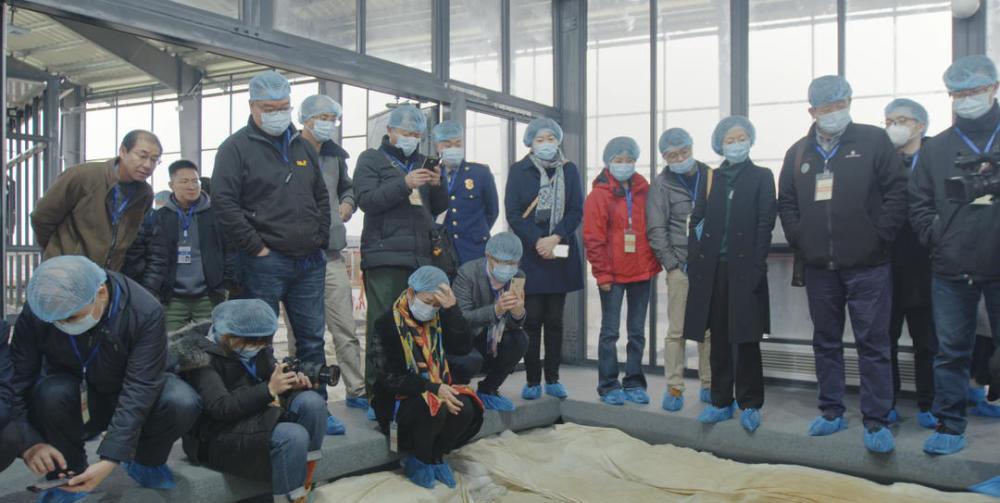
Experts look at pit 4 ash layer
Cover news reporter Zeng Jie according to Sichuan Radio and Television Station
Archaeological discoveries and studies have shown that the history of silkworm silk making in the mainland can be traced back to the Stone Age, and the Sichuan region is one of the important origins of silk fabrics. Nevertheless, finding silk in archaeological excavations is not an easy task.
In 1986, Sanxingdui woke up to the world, and thousands of bronze artifacts were unearthed from two sacrificial pits, but due to the limitations of archaeological technology at that time, no traces of silk were found. More than 30 years later, how did archaeologists find silk fabrics from the dirt of Sanxingdui? What is the significance of the appearance of these silks? At 8:00 p.m. on April 30, the CCTV Documentary Channel will broadcast the second episode of the large-scale archaeological documentary "See Sanxingdui Again", "First Sight", about the "meticulousness" of archaeologists in the process of exploring silk.
In 2020, the Sanxingdui sacrifice area restarted archaeological excavations, and finding silk fabric relics is a goal that is both far and near. As far away as the silk fabric relics have not been found in the previous archaeological work in the Sichuan area, the recent is that before the official excavation of this round, the Sichuan Provincial Institute of Cultural Relics and Archaeology jointly carried out the search for silk relics with the China Silk Museum.
Guo Jianbo searched for silk objects
Earlier, they walked into the warehouse where the cultural relics excavated from the No. 1 and No. 2 sacrifice pits in 1986 were located, checked 13 types of utensils such as bronze eye bubbles, and more than 40 utensils, and detected the silk protein signal. This result is exciting, and archaeological evidence, myths, legends, and historical records corroborate each other, indicating that silk already existed in the ancient Shu region more than 3,000 years ago.
Guo Jianbo, a librarian at the Institute of Cultural Relics Protection of the Sichuan Academy of Cultural Relics and Archaeology, shouldered the task of finding silk objects in the new sacrifice pit during the excavation. After receiving this task, he left most of his time to the microscope. A tiny sample that has been magnified hundreds or thousands of times by a microscope can take hours to view. He looks for it during the day and at night, which can be called a realistic version of "meticulousness", and this requires patience and perseverance beyond ordinary people.
Golden Mask
At the same time, all the excavation modules were set up at the excavation site, and the archaeological teams of Shanghai University, Sichuan University and Peking University were also welcomed. Soon, good news came from the excavation site. Sacrifice No. 5 is about to unearth the first gold heavy vessel excavated in this round.
When everyone's attention was attracted by the golden mask, Guo Jianbo also ushered in an important moment. On January 31, 2021, he clearly remembered that about two o'clock in the afternoon, he finally saw a clear longitude and latitude organization under the microscope.
This discovery fills the gap in the archaeology of silk in the ancient Shu period, thus empirically confirming the glory of the ancient Shu civilization and providing new evidence for the study of the sacrificial form of Sanxingdui. Most importantly, it offers a possibility for the discovery of ancient Shu scripts and symbols. The golden mask in the sacrificial pit and a ray of longitude and latitude under the microscope finally crossed the millennium and saw the true face for the first time.
Silk protein testing at china silk museum
Whether it is the sand drawing on the Warring States copper pot unearthed in Chengdu Baihuatan, the Model of the Shu Brocade Loom excavated from the Tomb of Laoguanshan Han in Chengdu, or the titles of "Jinguancheng", "Jinjiang" and "Jinli" that continue to this day, all show that the Brocade Weaving Industry in Shudi has a long history and is famous for a while. As the capital of the ancient Shu state created by the ancestors of the ancient Shu, it is very reasonable to find silk in the sacrifice pit.
On April 30th, the first day of the May Day holiday, waiting for the CCTV Record Channel or Sichuan Satellite TV, the second episode of the "Sichuan-made" archaeological documentary "See Sanxingdui Again" and you "first met" to tell the wonderful journey of discovering silk.